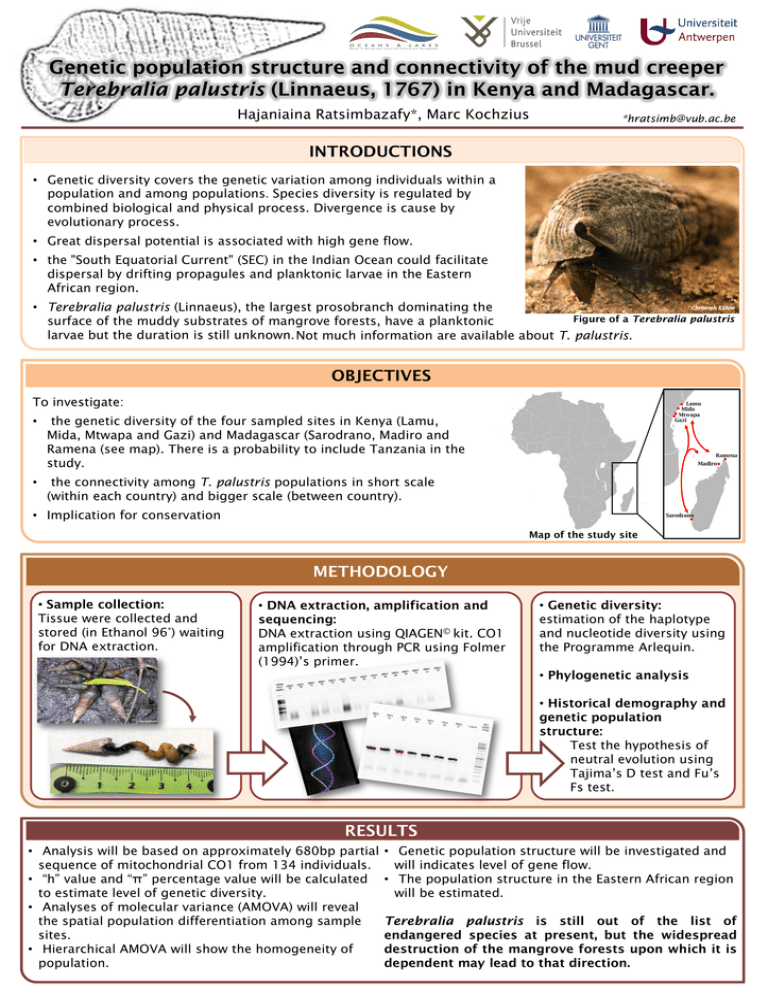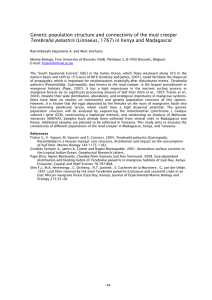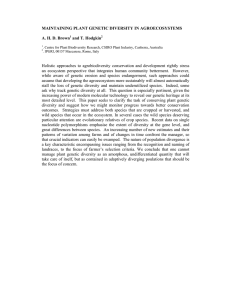Genetic population structure and connectivity of the mud creeper Terebralia palustris INTRODUCTIONS
advertisement

Genetic population structure and connectivity of the mud creeper Terebralia palustris (Linnaeus, 1767) in Kenya and Madagascar. Hajaniaina Ratsimbazafy*, Marc Kochzius *hratsimb@vub.ac.be INTRODUCTIONS • Genetic diversity covers the genetic variation among individuals within a population and among populations. Species diversity is regulated by combined biological and physical process. Divergence is cause by evolutionary process. • Great dispersal potential is associated with high gene flow. • the "South Equatorial Current" (SEC) in the Indian Ocean could facilitate dispersal by drifting propagules and planktonic larvae in the Eastern African region. • Terebralia palustris (Linnaeus), the largest prosobranch dominating the Figure of a Terebralia palustris surface of the muddy substrates of mangrove forests, have a planktonic larvae but the duration is still unknown. Not much information are available about T. palustris. OBJECTIVES To investigate: • the genetic diversity of the four sampled sites in Kenya (Lamu, Mida, Mtwapa and Gazi) and Madagascar (Sarodrano, Madiro and Ramena (see map). There is a probability to include Tanzania in the study. • the connectivity among T. palustris populations in short scale (within each country) and bigger scale (between country). • Implication for conservation Map of the study site METHODOLOGY • Sample collection: Tissue were collected and stored (in Ethanol 96°) waiting for DNA extraction. • DNA extraction, amplification and sequencing: DNA extraction using QIAGEN© kit. CO1 amplification through PCR using Folmer (1994)’s primer. • Genetic diversity: estimation of the haplotype and nucleotide diversity using the Programme Arlequin. • Phylogenetic analysis • Historical demography and genetic population structure: Test the hypothesis of neutral evolution using Tajima’s D test and Fu’s Fs test. RESULTS • Analysis will be based on approximately 680bp partial sequence of mitochondrial CO1 from 134 individuals. • “h” value and “π” percentage value will be calculated to estimate level of genetic diversity. • Analyses of molecular variance (AMOVA) will reveal the spatial population differentiation among sample sites. • Hierarchical AMOVA will show the homogeneity of population. • Genetic population structure will be investigated and will indicates level of gene flow. • The population structure in the Eastern African region will be estimated. Terebralia palustris is still out of the list of endangered species at present, but the widespread destruction of the mangrove forests upon which it is dependent may lead to that direction.









